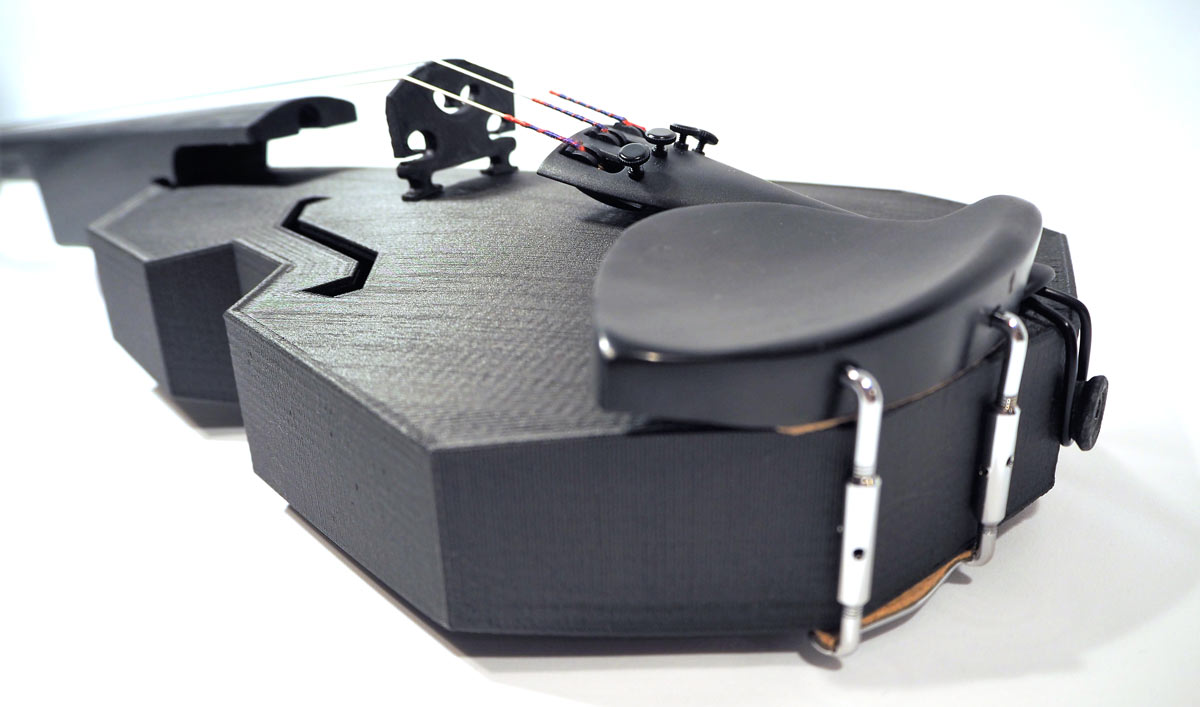While there have been many 3D printed violins since my electric F-F-Fiddle in 2013 (see also Make: Volume 40), this one is truly disruptive. Previously, all 3DP acoustic violins either required assembly similar to that of a traditional instrument, or they had poor sound. The Modular Fiddle is absurdly easy to assemble and has good sound — significantly better than a cheap wooden instrument.

The Modular Fiddle is a 3D printed, open source, modular violin that can be produced with medium-size FFF 3D printers and off-the-shelf components (Figures A, B, and C). It costs no more than $100 in materials and 4 hours or so in build time, and yields a good acoustic violin suitable for learning the instrument, solo playing, or playing in an acoustic jam.


Most important, the modularity provides a platform for experimentation and variation that’s never been possible before. This is a test bed for innovation in string instrument acoustics.
The Violin, Evolved
Physical products are slowly entering a new era, in which the combined power of the internet and digital manufacturing allow widespread distribution and experimentation with product design.
The Modular Fiddle is designed to quickly test experimental violin concepts. Some acoustic innovations are only possible using 3D printing! Concepts that test well can be incorporated into traditional violin methods to advance the craft for all stringed instruments.
Violin history is rich with variations, and many elements of the instrument have evolved slowly over time. Luthiers attempted to copy other luthiers, but they sometimes made small mistakes that resulted in improved acoustics. Such mistakes led to the modern shape of the F holes.
What if we could accelerate that natural iterative process tenfold, a hundredfold, exponentially? We haven’t seen a significant leap in violin design and construction since the invention of higher tension strings during the 18th century. We’re due!


Using advanced digital design software and the Modular Fiddle, violin design and acoustics are poised to take a significant leap. 3D printing allows never-before-possible acoustic structure. Emerging design techniques, such as generative design (Figures D and E), could have significant impacts on instrument weight and performance.
Despite all this, the wood used for violins has incredible properties, like its stiffness-to-weight ratio. The violin is a finely tuned, highly evolved, powerhouse machine for producing beautiful, clear, and projecting tones. Can a 3D-printed fiddle possibly match this quality? No — and it shouldn’t try to do so.
Good Sound Is Subjective
What we consider to be “good sound” changes over time. Desirable instrument sound is a combination of musical style, human psychology, and culture.
Currently, the Modular Fiddle has the sound quality and playability of a mid-range wooden violin with a noticeable decrease in volume and projection. While the current sound quality is impressive, our focus should not be on matching the quality of wood — instead we should try to create altogether different sounds.
Make Old Fiddles New Again

The modularity of this fiddle encourages experimentation. We can remix old instruments, like the Norwegian Hardanger fiddle or hardingfele. It’s got a long and colorful history and a very different sound. The Hardanger Fiddle Association of America says:
Its most distinguishing feature is the four or five sympathetic strings that run underneath the fingerboard and add echoing overtones to the sound. The traditional playing style is heavily polyphonic. A melody voice is accompanied by a moving “drone” voice. Together, the instrument and the playing style create the sound for which the Hardanger fiddle is famous.


The first major variation designed for the Modular Fiddle is a Modular Hardanger Fiddle (Figures F, G, and H). This instrument uses Hardanger strings and understrings to provide a Hardanger sound and playing experience.
Building Your Modular Fiddle


To build your own Modular Fiddle, you can download the parts lists and the design files for printing, and find complete build instructions at openfabpdx.com/fiddle. The 4-string version shown here is completely free and open source, while the 5-string (Figures I and J) and Hardanger files are available for $12.50. With the download you get both STL files and STEP files, allowing easy remixes no matter your CAD preference.
If you’d like to buy a kit of parts, or a fully built Modular Fiddle, check out openfabpdx.com/shop.
There’s also an active Google Group that supports all of OpenFab’s violin designs. Makers of both the Modular Fiddle and its predecessor the F-F-Fiddle should head to the OpenFab Violin Builders group to review discussion and ask questions.
What’s Next
I’m currently working to develop a new version of the 3D printed Modular Fiddle that’s resistant to creep and to the effects of heat. Initial tests have shown huge improvements by using annealed Proto-Pasta HTPLA-CF filament, a high-temperature, carbon fiber-reinforced PLA that can be heat treated after printing for extra strength. You can read more about my progress at blog.proto-pasta.com/anneal and blog.proto-pasta.com/hardanger.







